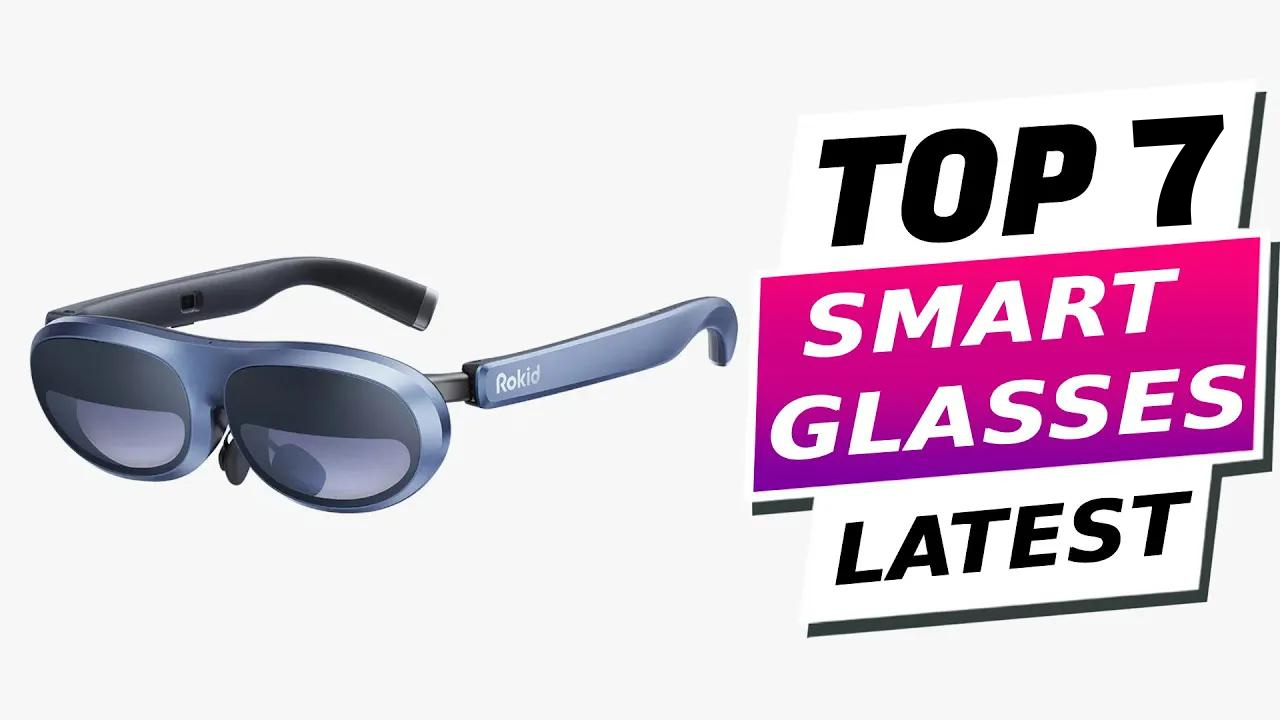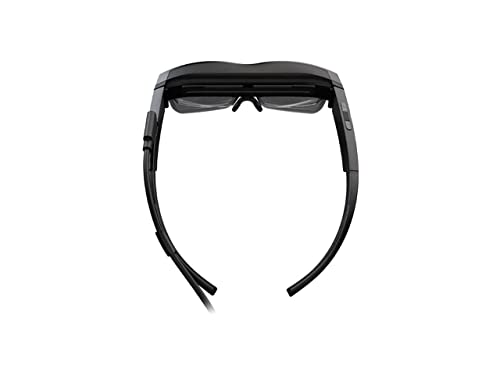The 7 Best AR Smart Glasses in 2024: You Must Have – Experience the Future!
Smart glasses have revolutionized the way we interact with technology, blending the digital and physical worlds seamlessly. In this article, we’ll explore the top 7 (Augmented Reality) best AR smart glasses of 2024, each offering unique features and capabilities. Whether you’re a tech enthusiast or someone looking to enhance your daily experiences, these cutting-edge devices are worth considering.
Best AR Smart Glasses in 2024: Quick Picks!
Certainly! If you’re short on time and can’t read articles, feel free to choose directly from our Picks.
Table of Contents
Top 7 Best AR Smart Glasses in 2024
1. XREAL Air 2 AR Glasses: Elevating Visual Experiences to New Heights

The XREAL Air 2 AR glasses mark a significant advancement in augmented reality technology, combining a lightweight, comfortable design with high-definition 1080p displays and a fluid 120Hz refresh rate. Ideal for gaming and media consumption, these glasses weigh just 75 grams and feature adjustable nose pads and temple tips for prolonged comfort.
The micro-OLED displays ensure stunning visuals with crisp resolution and smooth motion. Moreover, their wide compatibility with various devices through a USB-C connection, including phones, laptops, and gaming consoles, enhances their versatility.
The setup and usage are user-friendly, demanding minimal technical know-how. Despite their promising glimpse into the future of AR, potential buyers should weigh the glasses’ limited field of view, the absence of an internal battery, and the necessity of an additional accessory for full functionality.
2. Rokid Max AR Glasses: Immerse Yourself in Cinema-Grade Entertainment

Sharing similarities with the X-ReelAire, the Rokit Max AR glasses boast micro OLED displays that generate a virtual floating screen. Surpassing its counterpart with a screen output equivalent to a massive 215-inch display viewed from 10 feet away, the Rokit Max provides an incredibly immersive experience. These glasses feature a powerful speaker system delivering full audio with strong bass, making them ideal for media consumption.
With a 215-inch FHD 1080p OLED display, a wide 50-degree field of view, and a smooth 120Hz refresh rate, the Rokit Max ensures vibrant visuals and a fully immersive AR experience. The glasses’ lightweight build and adjustable nose pads provide lasting comfort for extended gaming sessions. Compatible with a variety of consoles, the Rokit Max delivers professional-grade acoustics and a delightful listening experience, making every entertainment moment unforgettable.
3. Ray-Ban Story Smart Glasses: Capturing Life’s Moments Hands-Free

Developed in collaboration between Facebook and Ray-Ban, the Ray-Ban Story Smart Glasses resemble ordinary sunglasses but come equipped with forward-facing cameras for photo and video capture. Despite the compact design, these glasses offer the convenience of a wearable camera, allowing users to effortlessly capture life’s special moments hands-free.
Equipped with dual 5MP cameras, these smart glasses automatically adjust to surrounding light, delivering high-resolution photos and quality videos of up to 60 seconds. With discreet open-ear speakers and three built-in microphones, Ray-Ban Stories capture sound from all directions, ensuring clear and crisp audio for recordings and calls. The glasses also feature a hyper-responsive touchpad for easy interaction, making them a convenient and stylish option for documenting adventures. Learn more about Ray-Ban Story Smart Glasses
4. Amazon Echo Frames: Your Personal Audio Assistant

If your primary requirement is audio playback, the second-generation Amazon Echo Frames are worth considering. These lightweight sunglasses feature open-air speakers providing clear and audible audio, making them perfect for listening to audiobooks and podcasts. Integrated with Amazon’s digital assistant Alexa, these frames allow users to summon it with voice commands and seek assistance.
Designed for all-day wear, the Echo Frames offer over two hours of talk time, Alexa interactions, and media playback throughout a 14-hour day. With a VIP filter feature for notifications, these frames allow users to customize which contacts and apps on their phones can send notifications, reducing unnecessary interruptions. Available in various lens options, including prescription-ready and polarized sunglasses, the Echo Frames offer a comfortable and immersive audio experience.
5. Lenovo Think Reality A3: Unleashing Productivity on the Go

For those seeking productivity on the go, Lenovo’s Think Reality A3 smart glasses offer an exciting solution. When connected to a Windows laptop, these glasses can project a virtual desktop with up to three screens at once, creating a customized and expanded personal workspace.
With advanced controls, including sensors for gaze-based navigation, the Think Reality A3 stands out in providing an immersive augmented reality experience. Designed for extended wear, these glasses offer a lightweight and comfortable build, catering to various face shapes. The glasses are also IPX4 splash-resistant, ensuring protection against water and sweat.
6. One XR/AR Glasses: Full HD Display, Spatial Video Supported

These are the glasses that come with a massive 120″ Full HD Display, providing a truly immersive visual experience. The Harman Sound technology ensures crystal-clear audio, enhancing overall enjoyment.
What’s even better is that these glasses are compatible with various devices like the iPhone 15/15 Pro, Steam Deck, ROG Ally, gaming consoles, PC, and Android, allowing me to enjoy a wide range of content. The Spatial Video support adds an extra wow factor, making the virtual reality feel incredibly realistic.
Another great feature is the Myopia Adjustments, which lets me use the glasses without my regular eyeglasses. It’s super convenient for people like me with myopia.
The Electrochromic Film technology adds a smart touch by automatically adjusting the glasses’ tint based on the lighting conditions, providing optimal viewing experience indoors and outdoors.
7. Nreal Air AR Glasses Micro: OLED Virtual Theater, Augmented Reality Glasses

I am impressed with this device. These smart glasses are lightweight and comfortable to wear. The Micro-OLED Virtual Theater provides a fantastic viewing experience, making it feel like you are in a virtual world.
The augmented reality feature is amazing. It enhances real-world objects with virtual elements, making everything more interactive and immersive. The glasses also have a streaming and gaming option, allowing you to enjoy your favorite games and movies on PC, Android, and iOS devices. You can even connect it to gaming consoles and cloud gaming platforms.
Setting up the glasses was a breeze. It provides a seamless connection between the glasses and your devices. The bundle comes with everything you need, ensuring a hassle-free experience.
Overall, the Nreal Air AR Glasses are a game-changer. They offer a high-quality, interactive, and futuristic experience. Whether you are a gamer or a movie enthusiast, these glasses are definitely worth investing in.
What is the difference between smart glasses and AR glasses?
Smart glasses and AR (Augmented Reality) glasses are similar in that they both allow users to view digital information in front of their eyes. However, there are some key differences between these two types of glasses.
Smart glasses are wearable devices that display information directly in the user’s field of vision. They typically have a small display screen, located above or to the side of the eye, that projects images or text. Smart glasses provide various functionalities, such as displaying notifications, making calls, and showing maps or directions. They can also connect to smartphones or other devices to access additional features. Smart glasses are designed to enhance the user’s day-to-day activities without completely altering their reality.
On the other hand, AR glasses are specifically designed to provide an augmented reality experience. They use advanced technology to overlay digital information onto the real world, seamlessly blending virtual objects or data with the user’s surroundings. These glasses have transparent lenses that allow users to see the real world while digital information, such as 3D models, text, or videos, is projected into their field of view. AR glasses are often used for gaming, visualizing complex data, training simulations, or offering interactive experiences with virtual objects.
The main difference between smart glasses and AR glasses lies in their primary purpose. Smart glasses focus on providing useful information and enhancing daily tasks, while AR glasses provide immersive, interactive experiences by merging virtual content with the real world.
Is augmented reality glasses worth it?
Augmented reality glasses can be cool if you really want to watch movies or use a mobile workstation with them. However, they are quite expensive at $379, so for most people, it’s better to skip buying them for now.
Is VR or AR more expensive?
Both Virtual Reality (VR) and Augmented Reality (AR) technologies can be expensive, but VR tends to be more expensive overall.
VR refers to a technology that creates an entirely simulated reality, where users are completely immersed in a computer-generated environment. To experience VR, users typically need a powerful computer or a dedicated gaming console, along with specialized VR headsets like the Oculus Rift or HTC Vive.
These headsets can cost several hundred dollars. Additionally, to enhance the VR experience, users may require additional accessories like hand controllers or sensors.
On the other hand, AR involves overlaying virtual elements onto the real world, enhancing our perception of reality. AR is commonly experienced through smartphones or tablets, using apps like Pokémon Go or Snapchat filters.
Since many people already own smartphones or tablets, the initial costs of accessing AR content are relatively lower compared to VR. However, specialized AR devices like the Microsoft HoloLens can be quite expensive, with prices reaching thousands of dollars.
Overall, VR tends to be more expensive due to the need for powerful computers or gaming consoles, dedicated VR headsets, and additional accessories.
AR, in contrast, typically relies on devices people already own, such as smartphones or tablets, making it more accessible in terms of cost.
Why is VR better than AR?
VR (Virtual Reality) is considered better than AR (Augmented Reality) in some aspects because it provides a fully immersive experience. In VR, users wear a headset that completely covers their eyes, transporting them to a different digital world.
This allows individuals to escape the real world and engage in various experiences or activities. On the other hand, AR overlays digital objects in the real world, enhancing what we can see around us.
Here are a few reasons why VR can be seen as superior to AR:
1. Immersion: VR offers a sense of complete immersion where users feel like they are physically present in a virtual environment. This immersion can result in a more engaging and intense experience compared to AR, where the digital content is blended with the real world.
2. Deep Exploration: VR enables users to explore entirely new environments or realms that might not exist in reality. This level of exploration may not be achievable through AR, as it mostly adds digital elements to the existing physical environment.
3. Focus: With VR, users can focus solely on the virtual environment without any external distractions. This focused experience allows for a deeper level of engagement and concentration, enhancing the overall experience.
It is important to note that both VR and AR have unique applications and advantages within different contexts. AR can be useful for overlaying information onto real-world objects, such as navigation instructions, while still maintaining awareness of the environment.
Additionally, AR is more accessible as it can be experienced through smartphones, without requiring dedicated headsets.
Learn More Augmented Reality Technology: Time, Innovation, & Transformation Journey
Conclusion
In conclusion, these top 7 AR smart glasses cater to different preferences and use cases, providing users with a diverse range of options to enhance their digital experiences. Whether you’re into immersive gaming, hands-free documentation, or seamless productivity, there’s a smart glass for everyone. Thank you for exploring these cutting-edge devices with us. If you found this article helpful!
Last update on 2024-10-22/Affiliate links / Images from Amazon Product Advertising API






















One Comment